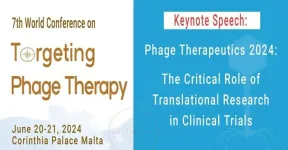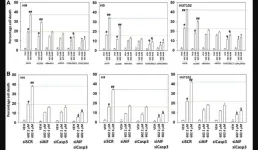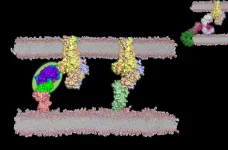(Press-News.org) For years, niobium was considered an underperformer when it came to superconducting qubits. Now scientists supported by Q-NEXT have found a way to engineer a high-performing niobium-based qubit and so take advantage of niobium’s superior qualities.
When it comes to quantum technology, niobium is making a comeback.
For the past 15 years, niobium has been sitting on the bench after experiencing a few mediocre at-bats as a core qubit material.
Qubits are the fundamental components of quantum devices. One qubit type relies on superconductivity to process information.
Touted for its superior qualities as a superconductor, niobium was always a promising candidate for quantum technologies. But scientists found niobium difficult to engineer as a core qubit component, and so it was relegated to the second string on Team Superconducting Qubit.
Now, a group led by Stanford University’s David Schuster has demonstrated a way to create niobium-based qubits that rival the state-of-the-art for their class.
“This was a promising first foray, having resurrected niobium junctions. … With niobium-based qubits’ broad operational reach, we open up a whole new set of capabilities for future quantum technologies.” — David Schuster, Stanford University
“We’ve shown that niobium is relevant again, expanding the possibilities of what we can do with qubits,” said Alexander Anferov of the University of Chicago’s Physical Science division, one of the lead scientists of the result.
The team’s work is published in Physical Review Applied and was supported in part by Q-NEXT, a U.S. Department of Energy (DOE) National Quantum Information Science Research Center led by DOE’s Argonne National Laboratory.
By harnessing niobium’s standout features, scientists will be able to expand the capabilities of quantum computers, networks and sensors. These quantum technologies draw on quantum physics to process information in ways that outclass their traditional counterparts and are expected to improve areas as varied as medicine, finance and communication.
The niobium advantage
When it comes to superconducting qubits, aluminum has ruled the roost. Aluminum-based superconducting qubits can store information for a relatively long time before the data inevitably disintegrates. These longer coherence times mean more time for processing information.
The longest coherence times for an aluminum-based superconducting qubit are a few hundred millionths of a second. By contrast, in recent years, the best niobium-based qubits yielded coherence times that are 100 times shorter — a few hundred billionths of a second.
Despite that short qubit lifetime, niobium held attractions. A niobium-based qubit can operate at higher temperatures than its aluminum counterpart and so would require less cooling. It can also operate across an eight-times-greater frequency range and a massive 18,000-times-wider magnetic field range compared to aluminum-based qubits, expanding the menu of uses for the superconducting-qubit family.
In one respect, there was no contest between the two materials: Niobium’s operating range trounced aluminum’s. But for years, the short coherence time made the niobium-based qubit a nonstarter.
“No one really made that many qubits out of niobium junctions because they were limited by their coherence,” Anferov said. “But our group wanted to make a qubit that could work at higher temperatures and a greater frequncy range — at 1 K and 100 gigahertz. And for both of those properties, aluminum is not sufficient. We needed something else.”
So, the team had another look at niobium.
Losing the lossiness
Specifically, they had a look at the niobium Josephson junction. The Josephson junction is the information-processing heart of the superconducting qubit.
In classical information processing, data comes in bits that are either 0s or 1s. In quantum information processing, a qubit is a mixture of 0 and 1. The superconducting qubit’s information “lives” as a mixture of 0 and 1 inside the junction. The longer the junction can sustain the information in that mixed state, the better the junction and the better the qubit.
The Josephson junction is structured like a sandwich, consisting of a layer of nonconducting material squeezed between two layers of superconducting metal. A conductor is a material that provides easy passage for electrical current. A superconductor kicks it up a notch: It carries electrical current with zero resistance. Electromagnetic energy flows between the junction’s outer layers in the mixed quantum state.
The typical, trusty aluminum Josephson junction is made of two layers of aluminum and a middle layer of aluminum oxide. A typical niobium junction is made of two layers of niobium and a middle layer of niobium oxide.
Schuster’s group found that the junction’s niobium oxide layer sapped the energy required to sustain quantum states. They also identified the niobium junctions’ supporting architecture as a big source of energy loss, causing the qubit’s quantum state to fizzle out.
The team’s breakthrough involved both a new junction arrangement and a new fabrication technique.
The new arrangement called on a familiar friend: aluminum. The design did away with the energy-sucking niobium oxide. And instead of two distinct materials, it used three. The result was a low-loss, trilayer junction — niobium, aluminum, aluminum oxide, aluminum, niobium.
“We did this best-of-both-worlds approach,” Anferov said. “The thin layer of aluminum can inherit the superconducting properties of the niobium nearby. This way, we can use the proven chemical properties of aluminum and still have the superconducting properties of niobium.”
The group’s fabrication technique involved removing scaffolding that supported the niobium junction in previous schemes. They found a way to maintain the junction’s structure while getting rid of the loss-inducing, extraneous material that hampered coherence in previous designs.
“It turns out just getting rid of the garbage helped,” Anferov said.
A new qubit is born
After incorporating their new junction into superconducting qubits, the Schuster group achieved a coherence time of 62 millionths of a second, 150 times longer than its best-performing niobium predecessors. The qubits also exhibited a quality factor — an index of how well a qubit stores energy — of 2.57 x 105, a 100-fold improvement over previous niobium-based qubits and competitive with aluminum-based qubit quality factors.
“We’ve made this junction that still has the nice properties of niobium, and we’ve improved the loss properties of the junction,” Anferov said. “We can directly outperform any aluminum qubit because aluminum is an inferior material in many ways. I now have a qubit that doesn’t die at higher temperatures, which is the big kicker.”
The results will likely elevate niobium’s place in the lineup of superconducting qubit materials.
“This was a promising first foray, having resurrected niobium junctions,” Schuster said. “With niobium-based qubits’ broad operational reach, we open up a whole new set of capabilities for future quantum technologies.”
This work was supported by the DOE Office of Science National Quantum Information Science Research Centers as part of the Q-NEXT center. It was partially supported by the University of Chicago Materials Research Science and Engineering Center, which is funded by the National Science Foundation.
This research was conducted by researchers at DOE’s Argonne National Laboratory, DOE’s Fermi National Accelerator Laboratory, the DOE’s SLAC National Accelerator Laboratory, Stanford University and the University of Chicago.
About Q-NEXT
Q-NEXT is a U.S. Department of Energy National Quantum Information Science Research Center led by Argonne National Laboratory. Q-NEXT brings together world-class researchers from national laboratories, universities and U.S. technology companies with the goal of developing the science and technology to control and distribute quantum information. Q-NEXT collaborators and institutions have established two national foundries for quantum materials and devices, develop networks of sensors and secure communications systems, establish simulation and network test beds, and train the next-generation quantum-ready workforce to ensure continued U.S. scientific and economic leadership in this rapidly advancing field. For more information, visit https://q-next.org/.
Argonne National Laboratory seeks solutions to pressing national problems in science and technology. The nation’s first national laboratory, Argonne conducts leading-edge basic and applied scientific research in virtually every scientific discipline. Argonne researchers work closely with researchers from hundreds of companies, universities, and federal, state and municipal agencies to help them solve their specific problems, advance America’s scientific leadership and prepare the nation for a better future. With employees from more than 60 nations, Argonne is managed by UChicago Argonne, LLC for the U.S. Department of Energy’s Office of Science.
The U.S. Department of Energy’s Office of Science is the single largest supporter of basic research in the physical sciences in the United States and is working to address some of the most pressing challenges of our time. For more information, visit https://energy.gov/science.
END
Resurrecting niobium for quantum science
Expanding possibilities for superconducting qubits
2024-02-26
ELSE PRESS RELEASES FROM THIS DATE:
Long-term data reveals SARS-CoV-2 infection and vaccine-induced antibody responses are long-lasting
2024-02-26
A long-term analysis conducted by leading microbiologists at the Icahn School of Medicine at Mount Sinai reveals that antibody responses induced by COVID-19 vaccines are long-lasting. The study results, published online in the journal Immunity on February 22, challenge the idea that mRNA-based vaccine immunity wanes quickly.
The emergence of SARS-CoV-2, the virus that causes COVID-19, in late 2019 sparked the global pandemic that is now in its fifth year. Vaccines that were developed at record speed have saved millions of lives. However, the emergence of SARS-CoV-2 variants and waning immunity have decreased ...
Shaping the future of phage therapy: The 7th World Conference on Targeting Phage Therapy in Malta aims to transform clinical trials through translational research
2024-02-26
The 7th World Conference on Targeting Phage Therapy 2024, two-day event dedicated to advancing the field of phage research and therapy will be hosted at Corinthia Palace Malta on June 20-21.
Robert T. Schooley, M.D., Professor of Medicine at the University of California, San Diego, Co-Director of the Center for Innovative Phage Applications and Therapeutics, and member of the Executive Committee for the University of California Disaster Resilience Network, will introduce the messages and strategies behind phages therapy 2024.
His talk titled “Phage Therapeutics 2024: Essential Translational Research Components for ...
GZ17-6.02 with bexarotene kills mycosis fungoides cells
2024-02-26
“The present studies were performed to extend our knowledge of GZ17-6.02 biology from that known in solid tumor cell types such as prostate cancer cells to liquid tumor cell types, for example, mycosis fungoides.”
BUFFALO, NY- February 26, 2024 – A new research paper was published in Oncotarget's Volume 15 on February 8, 2024, entitled, “GZ17-6.02 interacts with bexarotene to kill mycosis fungoides cells.”
In this new study, researchers Michael R. Booth, Laurence Booth, Jane L. Roberts, Cameron West, and Paul Dent from Virginia Commonwealth University and Genzada Pharmaceuticals investigated the therapeutic agent GZ17-6.02, composed of curcumin, ...
University of Tennessee Health Science Center professor awarded $1.5m to study 'root causes' of disparity in breast cancer survival of Black women and white women
2024-02-26
Memphis, Tenn. (February 26, 2024) – Shelley White-Means, PhD, a professor of Health Economics in the Department of Interprofessional Education and the director of the Consortium for Health Education, Economic Empowerment and Research (CHEER) at UT Health Science Center, recently received a $1.5 million, four-year grant from the National Institute on Minority Health and Health Disparities to explore the root causes of the disparity in breast cancer survival of Black women compared to white women.
Dr. White-Means and a team will look beyond the social determinants of health to explore what she terms “the intersectionality of race, ...
Steering and accelerating electrons at the microchip scale
2024-02-26
Stanford researchers are getting closer to building a tiny electron accelerator based on “accelerator-on-a-chip” technology with broad potential applications in studying physics as well as medical and industrial uses.
The researchers have demonstrated that a silicon dielectric laser accelerator, or DLA, can now both speed up and confine electrons, creating a focused beam of high-energy electrons. “If the electrons were microscopic cars, it’s as if, for the first time, we’re steering and we have our foot on the gas,” said Payton Broaddus, PhD ’23 in electrical engineering and the lead author on a paper published on ...
City of Hope scientists devise novel strategy to seek and destroy leukemia stem cells
2024-02-26
FINDINGS
Scientists at City of Hope, one of the largest cancer research and treatment organizations in the United States, have devised an innovative approach to target and destroy hard-to-kill leukemia stem cells. The journal Blood published the preclinical findings today.
By overcoming challenges, such as drug resistance and treatment relapse common to patients with acute myeloid leukemia (AML), the therapy method could provide a less toxic and more effective approach for older and sicker patients who don’t quality for stem cell transplants — currently the only cure for AML available.
Type II interferon (IFNy), a substance produced by immune cells, disrupts ...
Laser-focused look at spinning electrons shatters world record for precision
2024-02-26
NEWPORT NEWS, VA – Scientists are getting a more detailed look than ever before at the electrons they use in precision experiments.
Nuclear physicists with the U.S. Department of Energy’s Thomas Jefferson National Accelerator Facility have shattered a nearly 30-year-old record for the measurement of parallel spin within an electron beam – or electron beam polarimetry, for short. The achievement sets the stage for high-profile experiments at Jefferson Lab that could open the door to new physics discoveries.
In a peer-reviewed ...
BU researchers identify potential new subtype of chronic traumatic encephalopathy
2024-02-26
FOR IMMEDIATE RELEASE, February 26, 2024
Contact: Gina DiGravio, 617-358-7838, ginad@bu.edu
BU Researchers Identify Potential New Subtype of Chronic Traumatic Encephalopathy
One in six cases have a distinct distribution of disease, clinical profile
(Boston)—Chronic traumatic encephalopathy (CTE) is a neurodegenerative disease defined by abnormal tau protein accumulating in a particular pattern in specific regions of the brain.
Studies to-date suggest CTE begins in the outermost layer of the frontal lobe, the neocortex, where it then spreads to connected brain regions. Later, in high-stage disease, ...
BU researchers describe new technological platform to accelerate drug development
2024-02-26
EMBARGOED by Cell until 11 am ET Feb. 26, 2024
Contact: Gina DiGravio, 617-358-7838, ginad@bu.edu
BU Researchers Describe New Technological Platform to
Accelerate Drug Development
(Boston)— Drug development is currently an extremely long, expensive and inefficient process. Findings generated in a lab are often very hard to replicate once translated into animal models or in humans.
A family of pharmacological targets, on which approximately 35% of FDA-approved drugs work, consists of receptors at the surface ...
The small intestine adapt its size according to nutrient intake
2024-02-26
One of the most striking examples of gut plasticity can be observed in animals that are exposed to prolonged periods of fasting, such as hibernating animals or phyton snakes that goes for months without eating, where the gut shrinks with as much as 50%, but recovers in size following a few days of re-feeding. Importantly, the capacity of the gut to undergo resizing is broadly conserved. Hence, in humans, an increase in gut size is observed during pregnancy, which facilitates the uptake of nutrients to support the growth of the fetus.
The Colombani Andersen ...
LAST 30 PRESS RELEASES:
Superradiant spins show teamwork at the quantum scale
Cleveland Clinic Research links tumor bacteria to immunotherapy resistance in head and neck cancer
First Editorial of 2026: Resisting AI slop
Joint ground- and space-based observations reveal Saturn-mass rogue planet
Inheritable genetic variant offers protection against blood cancer risk and progression
Pigs settled Pacific islands alongside early human voyagers
A Coral reef’s daily pulse reshapes microbes in surrounding waters
EAST Tokamak experiments exceed plasma density limit, offering new approach to fusion ignition
Groundbreaking discovery reveals Africa’s oldest cremation pyre and complex ritual practices
First breathing ‘lung-on-chip’ developed using genetically identical cells
How people moved pigs across the Pacific
Interaction of climate change and human activity and its impact on plant diversity in Qinghai-Tibet plateau
From addressing uncertainty to national strategy: an interpretation of Professor Lim Siong Guan’s views
Clinical trials on AI language model use in digestive healthcare
Scientists improve robotic visual–inertial trajectory localization accuracy using cross-modal interaction and selection techniques
Correlation between cancer cachexia and immune-related adverse events in HCC
Human adipose tissue: a new source for functional organoids
Metro lines double as freight highways during off-peak hours, Beijing study shows
Biomedical functions and applications of nanomaterials in tumor diagnosis and treatment: perspectives from ophthalmic oncology
3D imaging unveils how passivation improves perovskite solar cell performance
Enriching framework Al sites in 8-membered rings of Cu-SSZ-39 zeolite to enhance low-temperature ammonia selective catalytic reduction performance
AI-powered RNA drug development: a new frontier in therapeutics
Decoupling the HOR enhancement on PtRu: Dynamically matching interfacial water to reaction coordinates
Sulfur isn’t poisonous when it synergistically acts with phosphine in olefins hydroformylation
URI researchers uncover molecular mechanisms behind speciation in corals
Chitin based carbon aerogel offers a cleaner way to store thermal energy
Tracing hidden sources of nitrate pollution in rapidly changing rural urban landscapes
Viruses on plastic pollution may quietly accelerate the spread of antibiotic resistance
Three UH Rainbow Babies & Children’s faculty elected to prestigious American Pediatric Society
Tunnel resilience models unveiled to aid post-earthquake recovery
[Press-News.org] Resurrecting niobium for quantum scienceExpanding possibilities for superconducting qubits





